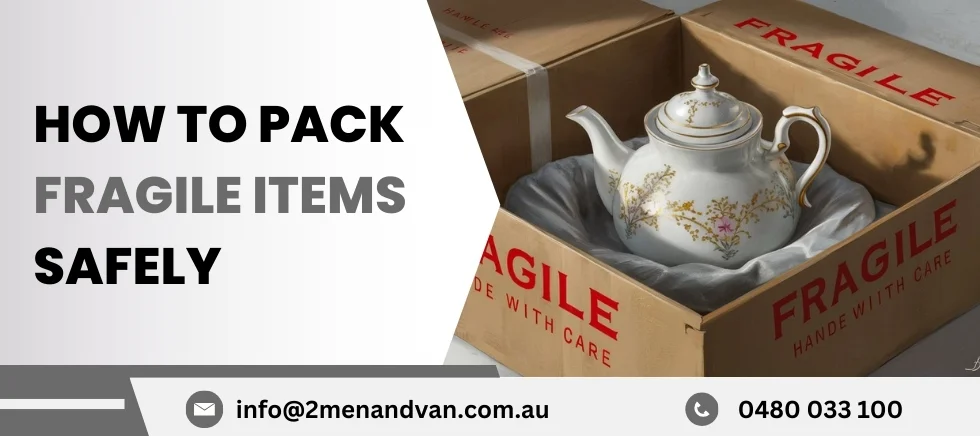Packing delicate items appropriately guarantees they will reach the assumed destination without any harm, whether shifting houses, doing business, or moving antiques. In this all-encompassing guide, we will discuss how to pack fragile items properly, emphasizing the peculiarities of antique moving in Brisbane and local small moves. It will help you reduce the likelihood of your items getting damaged while in transit and guarantee that your delicate goods are well taken care of. This guide will help you minimize the risk of damage during transit and ensure your fragile items are well-protected.
Understanding the Importance of Proper Packing
Fragile items, including glasses, chinaware, antiques, and electronics, are susceptible to physical shock and require appropriate packaging. For this reason, proper packing goes a long way in preserving the valuables from being damaged, as well as the time you will use to repurchase them. The process has to be well thought through, using suitable materials and techniques on how to pack fragile items.
Materials Needed for Packing Fragile Items
To begin packing, one must have all the essential items ready. Here’s a list of essential packing supplies:
- Sturdy Boxes: High-quality cardboard boxes of different sizes should be used. For additional security, double-walled boxes are advised.
- Bubble Wrap: It is ideal for wrapping delicate items like glassware, electronics, and ceramics.
- Packing Paper: Perfect for wrapping objects or fitting empty spaces in a packaging material.
- Packing peanuts or foam: This supports objects and does not allow them to move around and occupy free space.
- Tape: Strong packing tape should be used to seal the boxes when packing the car.
- Labels: When packing items that you know must not protrude out and must be oriented in a particular way, it is recommended that you label them using “fragile” and “this side up,” respectively.
- Marker: For printing on the boxes and listing the handling directions.
- Corner protectors: For things such as picture frames and mirrors.
- Scissors and Box Cutter: Slash packing materials and boxes, preferably with a sharp blade or carrier.
Steps to Pack Fragile Items Safely
Declutter and Organize
First, arrange by type—start with the delicate things you need to pack. Determine what needs to be saved, given away, or thrown away. This step equally helps minimize the number of things to pack; it also helps in a way that only items that are valuable or essential are moved.
Prepare Your Workspace
Create organization and purposefully place the work in a clean and large environment. Spread your packing material and ensure sufficient room to wrap and pack items without causing harm.
Wrap Each Item Individually
- Use packing paper: Delicate items such as glasses and ceramics should be wrapped separately using the packing paper. Please put the item in the middle of the paper, fold the corner, bring it closer, and twist the paper closely around it.
- Bubble Wrap for Extra Protection: If the items are incredibly delicate, wrap them again in bubble wrap. Ensure that the bubbles also face inside the item to protect it.
- Secure with Tape: To prevent the wrapping from unrolling, you must use tape to close it up and lock it in a set position.
Pack Items in Boxes
- Layer the Bottom of the Box: Make a layer of packing peanuts or crumpled paper at the base of the box to ensure a safe floor on which to place the items.
- Place Heavier Items First: While packing, arrange items that take up more space to pack in one box; arrange those that take up less space in the upper part of such a box to prevent them from being crushed by the weightier items put in the lower part of the box.
- Fill Gaps: This helps to ensure that items do not experience vibrations or shocks in transit. Use peanuts, foam, or crumpled paper to fill the space between the items. This restricts the motion and also minimizes the probability of getting hurt.
- Add a Top Layer: If you fill the box, you should cover the contents with extra packing material.
Seal and Label Boxes
- Secure with Tape: Leave no opening on its body by folding the box and using strong packing tape to stick any space that may be found. Focusing on the bottom seam and top seam will be good enough to make them more secure.
- Label Clearly: Take a marker and write ‘Fragile’ on a preferably big box so that you know which side should be on top. State the content to help unpack, especially if the plan is complex or lengthy.
Special Considerations for Antique Removals in Brisbane
Regarding antique removals Brisbane, extra precaution must be taken due to the value of the items as well as their uniqueness. Here are some tips specific to antique items:
- Professional Appraisal: It is recommended that before moving, you have your antiques appraised to make sure that they still hold a high value for you. This aids in ascertaining their worth, especially in circumstances that require them to obtain insurance.
- Insurance: See to it that your antiques are well-insured during transport. Again, consult any moving company or insurance company regarding your move’s available insurance.
- Custom Crating: Custom crating should be employed when the piece you are shipping is highly delicate or a valuable antique. These crates are designed according to the item’s measurements to be conveyed, thus offering the maximum shielding.
- Climate Control: Another problem in Brisbane is a relatively high humidity level, which can negatively impact old furniture. Where possible, the physical moving of goods should be done in air-conditioned moving vans to counteract the effects of temperature on goods.
- Professional Movers: Always go for professional movers, especially those with experience handling antique removals. They are in a position to handle delicate items, and they possess equipment to deal with valuable consignments.
Tips for Small Removals in Brisbane
For small removals Brisbane, such as moving a few fragile items across the city, efficiency and careful planning are essential. Here are some tips:
- Compact Packing: For those delicate items, it is advisable to pack them in smaller boxes. This, in turn, makes them easy to manage and lessens the chances of them getting damaged.
- Personal transport: Take some religious and susceptible items in your car if possible. This enables you to regulate how the items are managed and guarantee that they are not shaken during transport.
- Plan Ahead: Plan the route well to avoid places with bad roads or crowded areas with more traffic. With this, accidents and sudden halts that may harm your items are significantly reduced.
- Time of Day: Perhaps it is best to time the commute when other motorists are not on the road. This may be in the early morning or evening, when people are less likely to be around, hence the possibility of small removals.
Additional Tips for Packing Specific Fragile Items
Glassware
- Use Dividers: To make individual glasses retain their space within the box, it is advised to use cardboard dividers.
- Wrap Stems Separately: For the wine glasses, wrap the stems individually to avoid breaking them.
Plates and Dishes
- Vertical Packing: Stack tin plates and dishes in the manner of records, one on top of the other, with the backside of each plate resting on the next plate below. This decreases the contact area subjected to pressure and, thus, the chances of it being smashed.
- Padding Between Items: Put a sheet of packing paper or bubble wrap between each plate or dish.
Electronics
- Original Packaging: Anytime it is possible, ideally, pack the electronics in the original boxes and package the delivered products. Such boxes are meant to afford the specific items a snug fit and to conserve them against further damage.
- Remove Batteries: In this case, you should remove the batteries from the various electronics to avoid leakage or damage while in transit.
- Label cables: Be sure to label all the cables and accessories so that it is easier to do so when it comes to reassembly.
Mirrors and Picture Frames
- Use Corner Protectors: Put corner protectors on each of the four corners of mirrors and photo frames.
- Wrap in Bubble Wrap: Enclose the total piece in bubble wrap and fasten it using tape.
- Flat Packing: Stack mirrors and frames on the side of the box to avoid them moving in the transport vehicle.
Properly packing fragile items includes careful planning, suitable materials, and attention to minute details. Whether handling antique removals in Brisbane or any other small removal within the city limits, these guidelines will help ensure that your fragile items arrive intact. Remember to declutter and wrap items individually, use appropriate packing materials, and mark the boxes. Consider professional appraisal, insurance, and custom crating for precious antiques. By following these steps, you will feel more confident about keeping yourself and your valuables safe and having a stress-free relocation.
Related Post
- All About Moving Storage Services In Brisbane
- The Cheapest Times To Move
- Best Places to Live in Brisbane for Families
- Benefits Of Hiring Packing Services For Office And House Movers
- 10 Helpful Moving Tips For College Students
Contact Us Form
Related Blogs
A Moving Day Surprise: The Man and a Van Brisbane Team That Turned Disaster Into a Win
Moving day began as most do(as far as they thought). It was an early start, boxes neatly labelled, last-minute coffee. A quiet feeling that we get when all feels under control. This is a story of a family moving out. That too, from North Brisbane to Camp Hill, after...
Brisbane Moving Made Simple: Why 2 Men One Truck and Man With a Van Are Top Picks
Moving homes in Brisbane isn’t always about lifting heavy furniture. It’s about planning properly. When planning is missed, moving becomes a mix of calls, last-minute packing, favours from friends, waiting for tools and hoping the truck is big enough. This is why...
The Ultimate Furniture Removals Brisbane Guide: Save Money, Stress & Time
Most people searching for furniture removals Brisbane want one thing: a clear guide that helps them avoid the stress, delays, and surprise costs that often turn moving day into a long struggle. Across this guide are real-life situations in Brisbane—it takes into...






